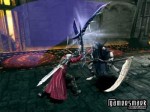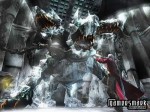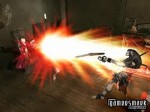Developer/Publisher: Sony Computer Entertainment || Overall: 8.0/10
Music games seem to be all the rage these days. When Guitar Hero came out it unearthed a new market for music games, allowing for the eventual “full band” music game in Guitar Hero: World Tour and Rock Band. However, only a few genres of music fit into this “full band” experience, leaving many genres of music out in the cold. The SingStar series lends itself towards being able to cover practically any song that has vocals in it, allowing for a more diversified line-up of genres in each edition of the game.
Thirty songs usually come in each SingStar title, and SingStar Pop Vol. 2 is no exception. Some songs that I like that made it into the game are “Duran Duran – Ordinary World,” “Evanescence – Bring Me To Life,” “Lifehouse – First Time,” “Sum 41 – Fat Lip,” and “The Outfield – Your Love.” Some really weird choices that I can’t even bring myself to play are songs like “Boys Like Girls – The Great Escape,” “Santana Feat. Chad Kroger – Into the Night,” and “Ashlee Simpson – Boyfriend.”
While there are more hits than misses in the compilation, I found the selection of songs mostly satisfying for a karaoke game. Being more used to Rock Band’s vocal visual system, I found it harder to keep in tune with the song (as much as I could, considering how horrible I am at singing in the first place) and say the words at the same time. SingStar Pop Vol. 2 is the first karaoke-only game I’ve really played when one considers that Rock Band itself is a mish-mash of karaoke and beat-keeping.
Vocal skills not withstanding, I did have a fun time playing the game with my roommates. Essentially, the game is a party game – something to play with other people in the same room as yourself. A caveat that comes with that, though, is that even though there are 30 songs to perform, it never feels like there’s enough. Both players have to agree on a song they want to sing, and sometimes that comes down to three or four songs that both want to try, let alone knowing how the song goes enough to attempt singing it. More often than not people don’t even want to try singing songs they don’t know.
Though you can hook up only two microphones, you can play with up to eight players through the game’s different modes. Other than straight out duels between two players, most of them consist of passing the mic to the next person in line after dividing up players into teams. The modes aren’t all that different from each other, but there’s only so much you can really do and most of that is already in the game.
Something that is also really nice about the SingStar games is the user interface. It looks slick, and looks cool even when simply messing around in the menu system as you set up your next game. It’s not overly complicated either, which results in getting what you want most of the time. While you play the game, the music video for the song plays in the background, so that during sequences where there may be solos or intros, you have something to watch while waiting for the vocals to come back in. Plus, it helps keep the other players occupied.
SingStar is based on points, and how many you earn during a song is the comparative factor against your opponent. Unlike other music games where you have to perform to a certain degree or get punished by “losing,” SingStar just lets you go through the whole song, no matter how horrible you are. In a way, it makes the game more fluid and the overall objective goes away from “beating” the song and more towards beating your opponent or getting the highest score you can.
On the PS2, SingStar games are typically available with the mics or without them at a cheaper price. New editions of the series come in at $40, while the packs with the mics can cost anywhere from $60 to $80 considering where you shop for it. The EyeToy can also be used in most (if not all) the SingStar games for extra functionality. Another cool aspect of the series is that it treats them all like the same game. The ability to swap out discs and quickly jump into another set of songs is a wonderful feature. PS3 users take note: This unfortunately didn’t work on my 60GB PS3 when I tried it, and it resulted in having to restart the console.
If you like straight-out karaoke games and still only have a PS2, the SingStar series is going to be the perfect game for your collection. While buying them all at the same time would cost a pretty penny, it’ll be worth it once a party gets going and people want to look through more songs, especially if you like most of the songs on any one edition. There’s also the promise of a future update to the PS3’s firmware that will allow the PS2 SingStar games to communicate with the PS3 versions, which would put more use to the PS2 versions of the game.



